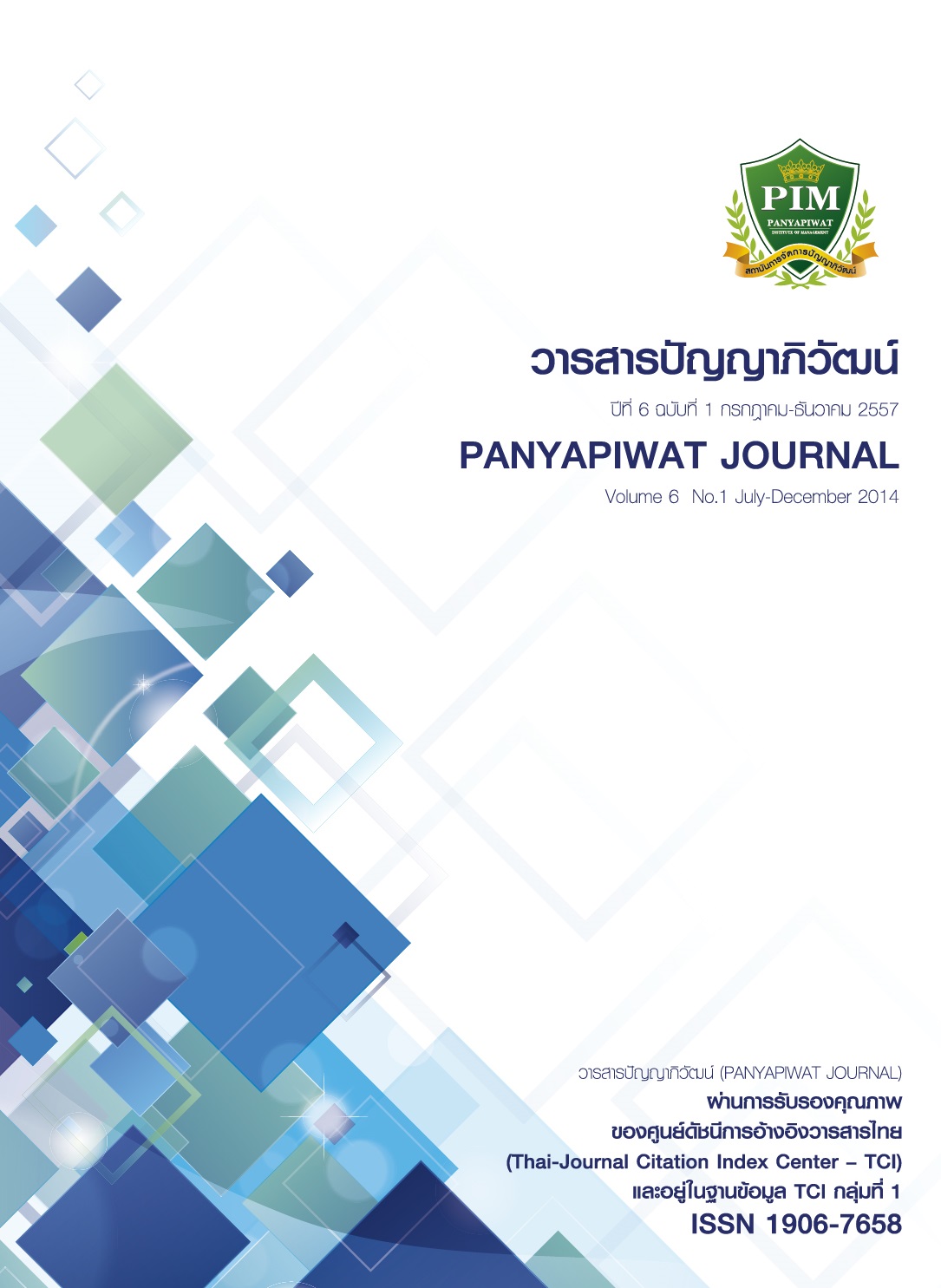อิทธิพลของส่วนประสมทางการตลาดต่อคุณค่าที่รับรู้ ความพึงพอใจ และความจงรักภักดีของลูกค้าร้านทอมชิค
Main Article Content
บทคัดย่อ
บทคัดย่อ
การวิจัยนี้มีวัตถุประสงค์ (1) เพื่อพัฒนาโมเดลอิทธิพลของส่วนประสมทางการตลาดต่อคุณค่าที่รับรู้ความพึงพอใจ และความจงรักภักดีของลูกค้า ในการเข้ามาใช้บริการเลือกซื้อผลิตภัณฑ์ของลูกค้าร้านทอมชิค (2) เพื่อตรวจสอบความสอดคล้องของโมเดลความสัมพันธ์เชิงสาเหตุที่พัฒนาขึ้นกับข้อมูลเชิงประจักษ์ประกอบด้วยตัวแปรแฝงจำนวน 7 ตัวแปร ได้แก่ ผลิตภัณฑ์ ราคา ช่องทางการจัดจำหน่าย การส่งเสริมการตลาด คุณค่าที่ลูกค้ารับรู้ความพึงพอใจของลูกค้า และความจงรักภักดีของลูกค้าร้านทอมชิคใช้ระเบียบวิธีการศึกษาวิจัยเชิงปริมาณโดยทำการวิจัยเชิงประจักษ์ใช้แบบสอบถามเป็นเครื่องมือในการเก็บรวบรวมข้อมูลจากลูกค้าที่เข้ามาเลือกซื้อเครื่องแต่งกายของร้านทอมชิคจำนวน 427 คน สถิติที่ใช้ในการวิเคราะห์ข้อมูล ได้แก่ การแจกแจงความถี่ การหาค่าเฉลี่ย การหาค่าร้อยละ และการวิเคราะห์โมเดลสมการโครงสร้าง
ผลการวิจัยแสดงว่า (1) โมเดลอิทธิพลของส่วนประสมทางการตลาดต่อคุณค่าที่รับรู้ ความพึงพอใจและความจงรักภักดีของลูกค้าในการเลือกซื้อผลิตภัณฑ์ของร้านทอมชิคมีความสอดคล้องกับข้อมูลเชิงประจักษ์อยู่ในเกณฑ์ดีค่าไค-สแควร์ เท่ากับ 233.57 ที่องศาอิสระ (df) 256 ค่าความน่าจะเป็น (p-value) เท่ากับ 0.92 ไค-สแควร์สัมพัทธ์ (χ2/df) เท่ากับ 0.881 ค่าดัชนีวัดระดับความกลมกลืน (GFI) เท่ากับ0.96 ค่าดัชนีวัดระดับความกลมกลืนที่ปรับแก้(AGFI) เท่ากับ 0.94 ค่าดัชนีค่าความคลาดเคลื่อนในการประมาณค่าพารามิเตอร์ (RMSEA) เท่ากับ 0.000 (2) นอกจากนี้ผลการวิจัยยังพบว่า (2.1) ส่วนประสมทางการตลาดในมิติด้านผลิตภัณฑ์มีอิทธิพลทางบวกต่อคุณค่าที่รับรู้ (2.2) ส่วนประสมทางการตลาดในมิติด้านราคามีอิทธิพลทางบวกต่อคุณค่าที่รับรู้ (2.3) ส่วนประสมทางการตลาดในมิติด้านช่องทางการจัดจำหน่ายมีอิทธิพลทางบวกต่อคุณค่าที่รับรู้ (2.4) ส่วนประสมทางการตลาดในมิติด้านการส่งเสริมการตลาดมีอิทธิพลทางบวกต่อคุณค่าที่รับรู้ (2.5) ส่วนประสมทางการตลาดในมิติด้านการส่งเสริมการตลาดมีอิทธิพลทางบวกต่อความพึงพอใจของลูกค้า (2.6) คุณค่าที่ลูกค้ารับรู้มีอิทธิพลทางบวกต่อความพึงพอใจของลูกค้า(2.7) คุณค่าที่ลูกค้ารับรู้มีอิทธิพลทางบวกต่อความจงรักภักดีของลูกค้า และ (2.8) ความพึงพอใจของลูกค้ามีอิทธิพลทางบวกต่อความจงรักภักดีของลูกค้า
Abstract
The objectives of this research were (1) to develop a causal relationship model of the influence of the marketing Mix on perceived values, customer satisfaction and customer loyalty of the customers who buy the products from Tomchic’s store and (2) to validate a causal relationship model of the influence of the marketing Mix on perceived values, customer satisfaction and customer loyalty of the customers who buy the products from Tomchic’s store. The model involved seven latent variables: product, price, place, promotion, perceived value, customer satisfaction and customer loyalty. The researchers used quantitative methods which involved
empirical research. The research tool was a questionnaire to collect data from 427 customers who buy the products from Tomchic’s store. The statistics used in data analysis were frequency, mean and structural equation model analysis.
Article Details
“ข้าพเจ้าและผู้เขียนร่วม (ถ้ามี) ขอรับรองว่า บทความที่เสนอมานี้ยังไม่เคยได้รับการตีพิมพ์และไม่ได้อยู่ระหว่างกระบวนการพิจารณาลงตีพิมพ์ในวารสารหรือแหล่งเผยแพร่อื่นใด ข้าพเจ้าและผู้เขียนร่วมยอมรับหลักเกณฑ์การพิจารณาต้นฉบับ ทั้งยินยอมให้กองบรรณาธิการมีสิทธิ์พิจารณาและตรวจแก้ต้นฉบับได้ตามที่เห็นสมควร พร้อมนี้ขอมอบลิขสิทธิ์บทความที่ได้รับการตีพิมพ์ให้แก่สถาบันการจัดการปัญญาภิวัฒน์หากมีการฟ้องร้องเรื่องการละเมิดลิขสิทธิ์เกี่ยวกับภาพ กราฟ ข้อความส่วนใดส่วนหนึ่งและ/หรือข้อคิดเห็นที่ปรากฏในบทความข้าพเจ้าและผู้เขียนร่วมยินยอมรับผิดชอบแต่เพียงฝ่ายเดียว”
เอกสารอ้างอิง
ฉัตยาพร เสมอใจ. (2547). สรุปรวม...สุดยอดกลยุทธ์การตลาด. พิมพ์ครั้งที่ 2. กรุงเทพฯ: ธรรกมลการพิมพ์.
ประดิษฐ์ จุมพลเสถียร. (2547). กลยุทธ์แข่งขันทางการตลาด. พิมพ์ครั้งที่ 1. กรุงเทพฯ: บริษัท พราวเพรส (2002) จำกัด.
ศิริชัย กาญจนวาสี, ทวีวัฒน์ ปิตยานนท์ และดิเรก ศรีสุโข. (2551).การเลือกใช้สถิติที่เหมาะสมสําหรับการวิจัย. พิมพ์ครั้งที่ 5. กรุงเทพมหานคร: จุฬาลงกรณ์มหาวิทยาลัย.
สุภมาส อังสุโชติ สมถวิล วิจิตรวรรณา และรัชนีกูล ภิญโญภานุวัฒน์. (2552). สถิติวิเคราะห์สําหรับการวิจัยทางสังคมศาสตร์และพฤติกรรมศาสตร์: เทคนิคการใช้โปรแกรม LISREL. พิมพ์ครั้งที่ 2. กรุงเทพฯ: เจริญดีมั่งคงการพิมพ์.
เสรี ชัดแช้ม. (2546). โมเดลสมการโครงสร้าง. วารสารวิจัยและวัดผลการศึกษา, 1(1), 1-24.
อัมพล ชูสนุก และกฤษณณัฐ หนุนชู. (2555). อิทธิพลของคุณภาพการให้บริการต่อคุณค่าตราสินค้า ความพึงพอใจ และความจงรักภักดีของลูกค้าทรูวิชั่นส์ในเขตกรุงเทพมหานคร. วารสารพาณิชยศาสตร์บูรพาปริทัศน์.7(1), 29-41.
อัมพล ชูสนุก และธนิดา ทิมทอง. (2012). อิทธิพลของส่วนประสมทางการตลาดบริการต่อคุณค่าตราสินค้า ความพึงพอใจและความจงรักภักดีของลูกค้าบริษัท ทรูมูฟ จำกัด ในเขตกรุงเทพมหานคร. RMUTT Global Business and Economics Review.7(2), 10-27.
อัมพล ชูสนุก และปรัศนียากรณ์ สายปิมแปง. (2555). อิทธิพลของส่วนประสมทางการตลาดต่อคุณค่าตราสินค้า คุณค่าที่รับรู้ ความพึงพอใจ และความจงรักภักดีของลูกค้า TrueMove 3G ในเขตกรุงเทพมหานคร. วารสารบริหารธุรกิจนิด้า. 11, 74-90.
อัมพล ชูสนุก และอังศุมาลิน เฮงมีชัย. (2556). อิทธิพลของคุณภาพการบริการต่อภาพลักษณ์ตราสินค้า คุณค่าตราสินค้า ความพึงพอใจ และความจงรักภักดีของลูกค้าที่ใช้บริการโรงเรียนสอนศิลปะดินสอสี. วารสารปัญญาภิวัฒน์. 4(2), 10-23.
Anderson, E. W., Fornell, C., & Lehman, D. R. (1994). Customer satisfaction, market share and profitability: Findings from Sweden. Journal of Marketing, 58(3), 53-67.
Barber, N., Goodman, R. J., & Goh, B. K. ( 2011). Restaurant consumers repeat patronage: A service quality concern.International Journal of Hospitality Management, 30(2), 329-336.
Caruana, A. (2002). Service loyalty: The effect of service quality and the mediating role of customer satisfaction. European Journal of Marketing, 36(7/8), 811-828.
Chen, C.-F., & Tsai, M.-H. (2008). Perceived value, satisfaction, and loyalty of TV travel product shopping: Involvement as a moderator. Tourism Management, 29(6), 1166-1171.
Chioveanu, I. (2008). Advertising, brand loyalty and pricing. Games and Economic Behavior, 64(1), 68-80.
Hair, J. F., Jr., Black, W. C., Babin, B. J., & Anderson, R. E. (2010). Multivariate data analysis (7 ed.). New Jersey: Prentice Hall.
Hansen, H., Samuelsen, B. M., & Silseth, P. R. (2008). Customer perceived value in B-t-B service relationships: Investigating the importance of corporate reputation. Industrial Marketing Management, 37(2), 206-217.
Grewal, D., Iyer, G. R., Krishnan, R., & Sharma, A. (2003). The Internet and the price-value-loyalty chain. Journal of Business Research, 56(5), 391-398.
Golob, T. F. (2003). Review structural equation modeling for travel behavior research. Transportation Research, 37(1), 1-25.
Kim, J.-H., & Hyun, Y. J. (2011). A model to investigate the influence of marketing-mix efforts and corporate image on brand equity in the IT software sector. Industrial Marketing Management,40(3), 424-438.
Kim, Y. K., & Lee, H. R. (2011). Customer satisfaction using low cost carriers.Tourism Management, 32(2), 235-243.
Kotler, P. (1997). Marketing management. NJ: Prentice Hall International.
Kotler, P. (2003). Marketing management. (11thed.). New Jersey: Prentice Hall.
Kotler, P., & Keller, L. K. (2006). Marketing management. New Jersey: Pearson Education.
Lai, W.-T., & Ching, C.-F. (2011). Behavioral intentions of public transit passengers: The roles of service quality, perceived value, satisfaction and involvement. Transport Policy, 18(2), 318-325.
Lewin, J. E. (2009). Business customers’ satisfaction: What happens when suppliers downsize?.Industrial Marketing Management, 38(3), 283–299.
Oliver, R. L. (1997). Satisfaction: A behavioral perspective on the consumer. New York: McGraw-Hill.
Orth, U. R., & Green, M. T. (2009). Consumer loyalty to family versus non-family business: The roles of store image, trust and satisfaction, Journal of Retailing and Consumer Services, 16(4), 248–259.
Ouksel, A. M., & Eruysal, F. (2010). Loyalty intelligence and price discrimination in a duopoly. Electronic Commerce Research and Applications, 10(5), 520-533.
Parasuraman, A., Zeithaml, V. A., & Berry, L. L. (1985). A conceptual model of service quality and its implications for future research. Journal of Marketing, 49(4), 41-50.
Shankar, V., Smith, A. K., & Rangaswamy, A. (2003). Customer satisfaction and loyalty in online and offline environments. International Journal of Research in Marketing, 20(2), 153-175.
Spiteri, J. M., & Dion, P. A. (2004). Customer value, overall satisfaction, end-user loyalty, and market performance in detail intensive industries. Industrial Marketing Management, 33(8), 675-687.
Turel, O., & Serenko, A. (2006). Satisfaction with mobile services in Canada: An empirical investigation. Telecommunications Policy, 30(5-6), 314–331.
Zeithaml, V. A. (1988). Consumer perceptions of price, quality and value: A means-end model and synthesis of evidence. Journal of Marketing, 52(3), 2-22.


